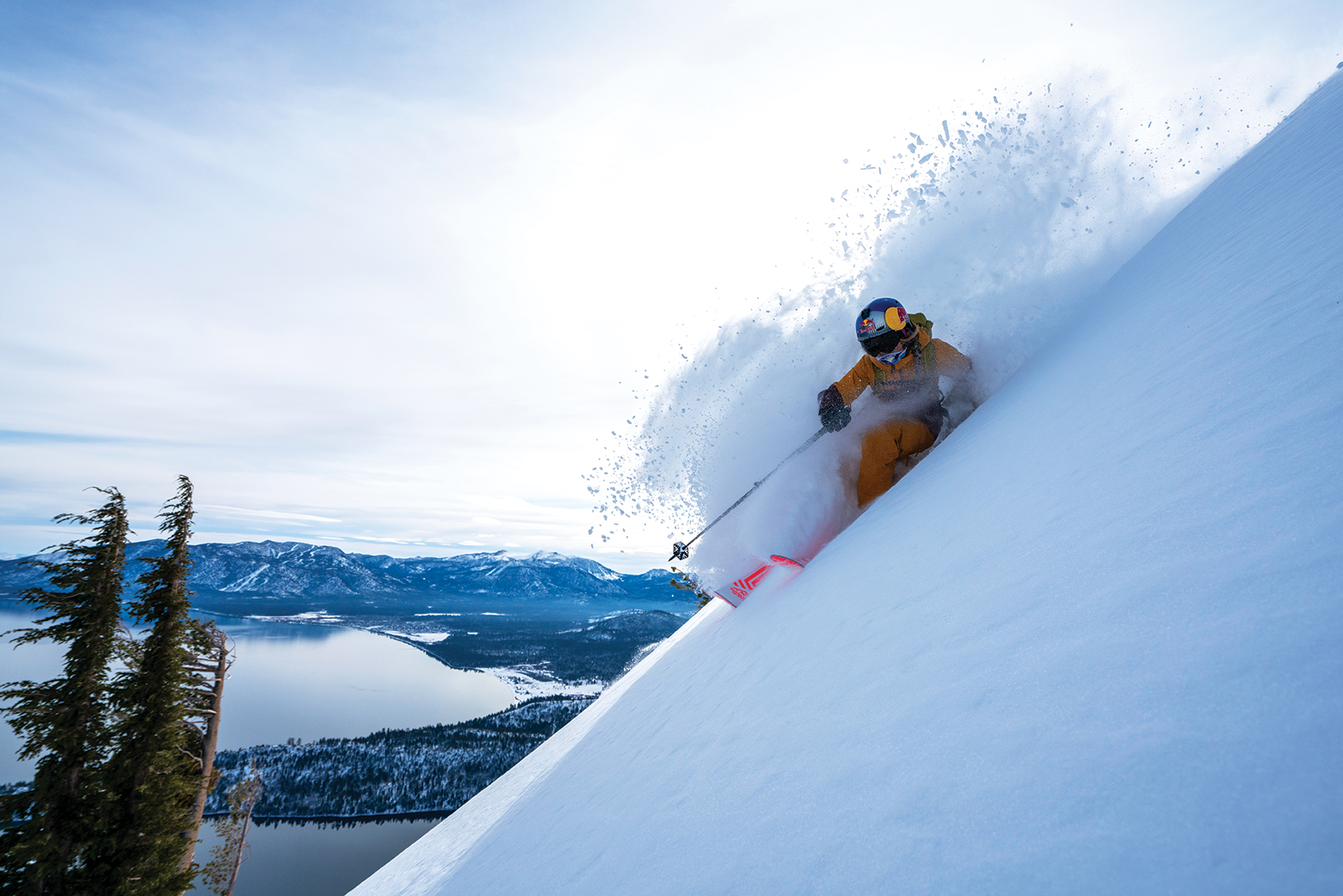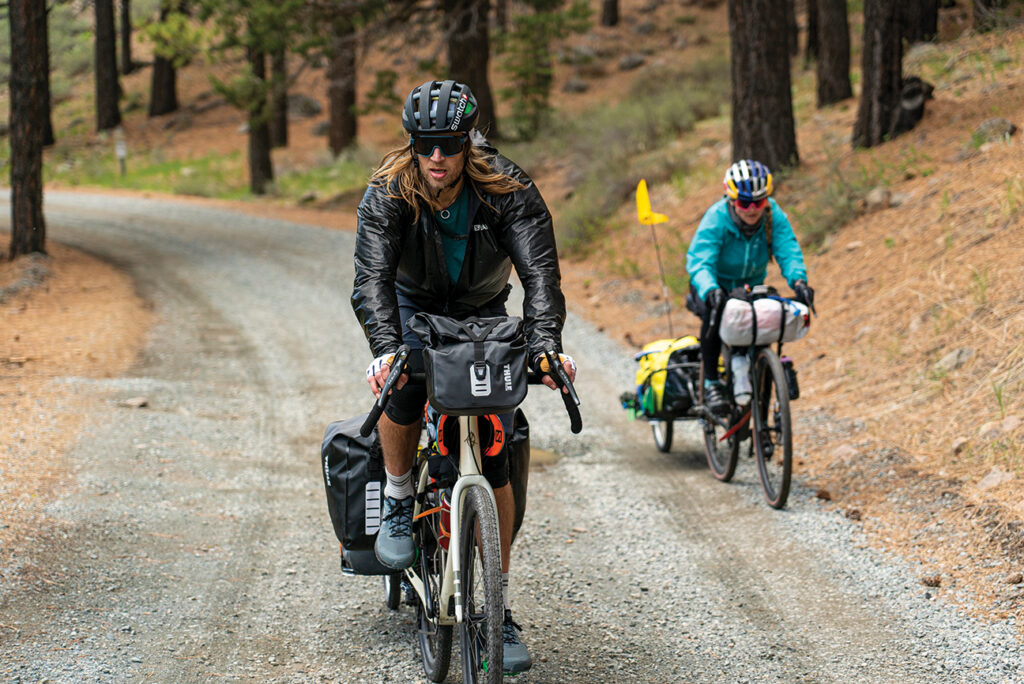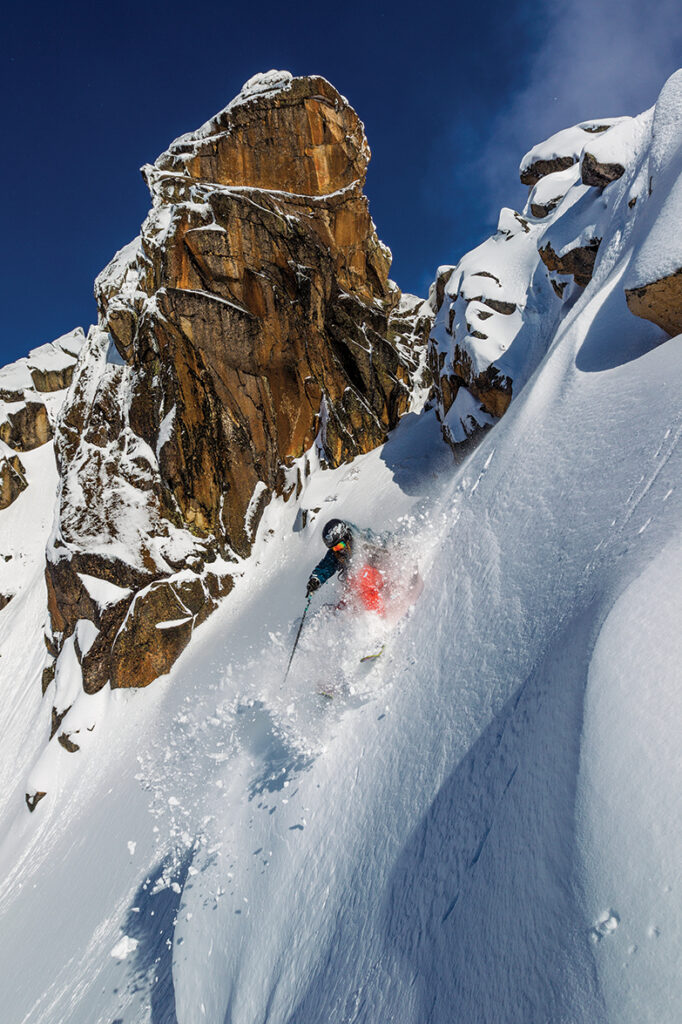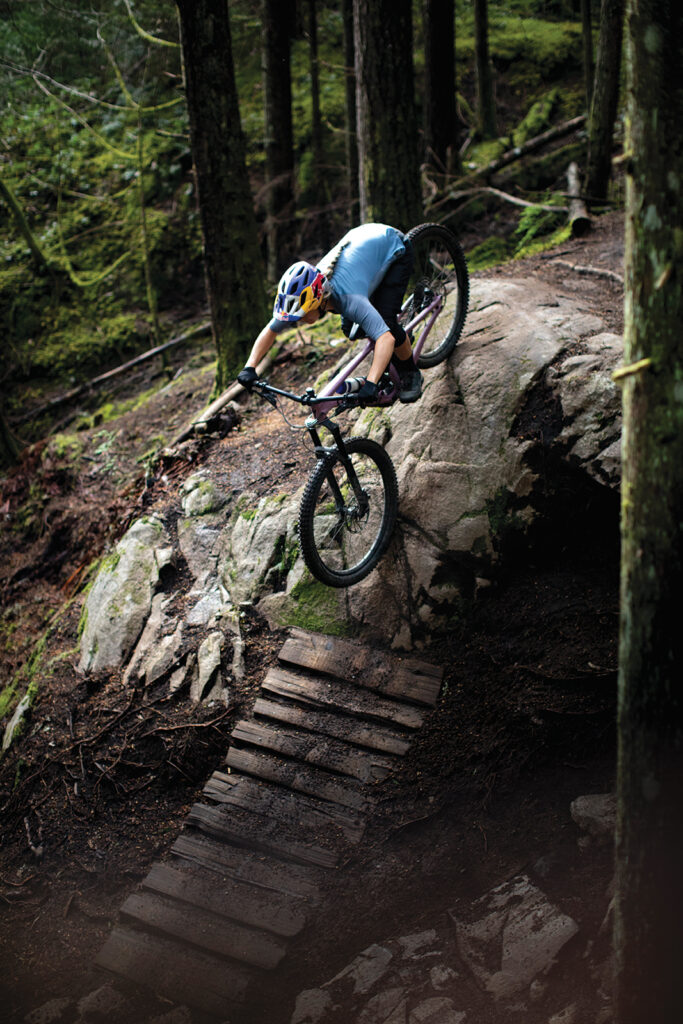
27 Sep Michelle Parker: Choosing Her Own Line

Cody Townsend and Michelle Parker pedal toward Eldorado Peak in Washington, photo by Bjarne Salén, courtesy Red Bull Content Pool
From young phenom to big-mountain veteran, Tahoe talent Michelle Parker has found success by following her heart
They weren’t expecting to hear gunshots on their way to the mountain.
In a beautiful, isolated stretch of woods in Darrington, Washington, Michelle Parker saw her mountain biking partner waiting for her along the trail. The path that she and Cody Townsend were on was a decommissioned railroad that cut through farmland and forest. On Townsend’s map, he could see that a few homes were scattered throughout the area, but the dense, mossy foliage cloaked any structures from view. That made it hard to distinguish where exactly those persistent pop sounds—definitely gunfire—were coming from.
Parker pulled up. “I think we should ride through this section together,” Townsend said. They set off again, cautiously this time. A little yellow flag fluttered behind Parker’s gear trailer. A few days back, she had rigged it with tape to spell out “B.L.M.” A river rambled alongside them. Otherwise, it was quiet.
The professional big-mountain skiers from Tahoe were on their way north, 900 miles deep into a 1,000-mile bike-packing trip. Headed for the serrated East Ridge of Eldorado Peak, Townsend and Parker were on a mission to cross off three remaining spots in the Pacific Northwest before the snow melted.
As a part of his ongoing quest to climb up and ski down all the mountains listed in The Fifty Classic Ski Descents of North America, Townsend had dreamed up a safe workaround to pandemic restrictions that would keep his project on schedule. He’d bike to his ski destinations from his home in Tahoe. On this portion of his mission, Parker, a childhood friend, would come along for the ride. Photographer Bjarne Salén would follow them with van support, filming along the way as they hit Mount Hood and Mount Rainier, and then Eldorado.
On the forested path now, separated from Salén’s van, Parker and Townsend cycled along, listening for gunfire. Nothing.
After a few minutes, they emerged into a small dirt crossroad. A single, sharp crack rang through the air, seemingly only a few dozen feet away. Townsend swore, his heart skipping a beat, and bolted through the clearing. Parker was hot on his heels, standing on her pedals, hunched into the position she hoped would make her a smaller target.
Parker is a big proponent of finding ways to have fun, both Type I (immediate) and Type II (miserable in the moment, enjoyable in retrospect). Getting shot at in rural Washington, even if it was just scare tactics, didn’t exactly register on that scale.
But she has pushed through devastating losses and injuries that might have ended another athlete’s career. She’s known as a skier who continues to reinvent her career as the sport evolves. Never knowing what she’s going to do tomorrow, she always somehow ends up finding the best thing to do that day, be it freeskiing in the backcountry, hauling herself up a sheer slab of granite or ripping down Tahoe singletrack on a mountain bike.
On this particular day in June 2020, however, she and Townsend had reached a low point in their mission.
“What a time to be on the road,” Parker thought as she pedaled to a safe location and climbed off her bike, trying to process what had just happened. “What a crazy, divided country.” And then, once the shock wore off: “What we’re doing here doesn’t mean anything. What’s the point of this?”
Inspired by Nature
On the first clear day in weeks during the smoke-filled 2021 summer, Parker politely cancelled her interview for this story, and instead went on a long mountain bike ride. The skies were blue, and she was in a great mood. She wanted to take full advantage of the nice day.
Parker is 5-foot-2, so the adjective “little” gets thrown around a lot when friends describe her—she’s a “little charger,” a “little fireball,” a “little pint of energy,” a “little spark of light.” She’s training for a race this fall, the Trans-Cascadia Backcountry Enduro, where she’ll climb thousands of feet every day over a week. When the weather’s inviting in her beloved Tahoe home, she just can’t stop being outside. After her bike ride, she played a round of golf with her dad. Later, she went for a run.
Like a lot of skiers around the lake, Parker considers the mountains a kind of church. It’s why she prefers skinning or hiking over snowmobiling out to her lines in the backcountry; everything feels more solid, slower, more human. It’s a connection she’s dedicated to for life.
“It’s not a phase. It’s not because I’m a professional skier. I love them,” Parker says. “They’re something that I’ve built my life around.”
Last April, she went touring in the backcountry on her birthday. She was riding with Townsend and his wife Elyse Saugstad when Towsend started talking about “The Fifty” project and his plans for the month-long bike-packing trip. Before he’d finished describing it, Parker interrupted to ask if she could come along. Townsend readily agreed; he’d been building up to inviting her anyway.
“If you have an adventure in mind, and you need a partner, give Michelle a call,” says Saugstad, who admits to thinking that her husband and friend were both insane for wanting to do it.
A big-mountain skier with a background in racing and freestyle, Parker’s style is low-to-the-snow, with strong, fluid turns and a playful, creative approach to the terrain.
Her versatility is perhaps her greatest asset, says ski legend and friend Ingrid Backstrom: “She could go throw down and do some tricks on a rail, but she could also go shred powder.”
In fact, when Parker started skiing massive lines in the backcountry, well over a decade ago now, she helped usher in a new era in the sport—one that brought the stylish flips and spins of freestyle skiing into the big-mountain realm.
As freeskiing has progressed, with more daring lines and tricks becoming the norm, Parker’s presence among skiing’s elite has never wavered. Nor has her love for the sport. Tahoe-based adventure photographer Ming Poon says he doesn’t know many people who ski more than Parker, who still attacks big, technical lines with a mega-watt grin, her easygoing and endlessly enthusiastic personality shining brightest when out in nature.
“When she’s doing all the things that she loves, I think it fuels her,” says Saugstad. “You know, so it perpetuates itself.”
Finding Her Niche
Scott Gaffney will never forget the moment he saw Parker for the first time. He was riding up KT-22 with a friend, JT Holmes. Below their dangling skis, they saw a small figure send it off a cliff in the Fingers, a notoriously spiny rock zone that’s not for the faint of heart.
Gaffney, the director of Matchstick Productions, was astonished. “That’s Michelle Parker,” Holmes said of the young teen.
Like many Tahoe kids, Parker was practically born with skis attached to her feet. At 18 months, she was zooming downhill in a tiny pink snowsuit. She was a Mighty Mite by 3, racing competitively by 6 and shredding the peppery, stomach-dropping Palisades before she hit double-digits. She was a workaholic (at one point working 52 days straight in a pottery shop as a high schooler on summer vacation) who grew up with posters of female athletes like Mia Hamm, Kristi Leskinen, Sarah Burke and Ingrid Backstrom on her bedroom walls.
In between bashing gates and clambering onto podiums, she started hanging in the terrain park. Though she mutilated the bases of her racing skis by sliding rails, throwing tricks offered a totally new and exhilarating kind of freedom from the strict regimen of racing gates. Townsend, who ran in a pack with Parker’s older brother, started hearing more and more about the little park rat who was doing 720s over 100-foot tables.
Asked where Parker gets her passion, Saugstad laughs. “Genetics,” she says.
Skiing runs marrow-deep in Parker’s family. Her mom, LuAnn, gets up at the crack of dawn to catch the first snowfall of each season, and her dad, Greg, would regularly write excuse notes to his daughter’s grade-school teachers on powder days so they could go rip for hours.
By the time she turned 16, Parker had become a dedicated freestyler, competing in slopestyle and halfpipe competitions at the U.S. Open and Winter X Games. Despite her success, however, Parker found that the contest scene was not for her.
“It started to feel too competitive with other women,” she says. “My happiest place was when I was in the mountains with my girlfriends, together and pushing each other. You’d be super psyched, skiing with your buds one day, and the next day you’d be competing. I didn’t like that vibe.”
So Parker distanced herself from the competition scene, focusing instead on backcountry adventures in big mountains.
“Why people like Michelle rise to the top is because you keep challenging yourself. You don’t walk away,” says Townsend. “You think, ‘Maybe I can do that.’ And I think that was a big question for the bike trip. She had a question in herself: ‘Can I ride a thousand miles and ski big lines off my bike?’ I had the same question. And the only way you can fully answer that question is to try.”
That they did. They cranked through mileage, biking eight to 10 hours a day. The monotony was excruciating, as was waking up every morning stiff and sore. Parker and Townsend have always had a little-sister-big-brother dynamic, but now they were just exhausted and irritated with one another. And that was all in the first week.
Six days in, Parker gave herself a much-needed pep talk. “We’re freakin’ hammering through this,” she told herself. “It’s a race. It’s going to be hard, but that’s what it is.”
She grabbed Townsend, too, and voiced her frustration. They talked it out, and by the end of it, Parker’s signature smile was back on her face.
“When we’re in the mountains,” says Poon, “sometimes we’ll be suffering. And she’s the perfect person to look back at and talk to you about it, and just laugh with—just laugh about how horrible it all is.”
Persistence Pays Off
It was after Parker had a nasty ski accident in 2009, while filming what she hoped would be her backcountry breakout segment for Matchstick’s In Deep, that she truly learned what “grin and bear it” means. Catching major air and landing on a rock with a force that snapped two ligaments and did some serious cartilage damage, Parker would not return to fighting form for nearly a year.
Gaffney was in a nearly identical position at the time. Skiing inbounds, he threw a spontaneous front flip and “basically just exploded” his knee. They both needed anterior cruciate ligaments (ACL) reconstructions and went through a particularly torturous two months of physical therapy together.
Parker’s sponsors dropped her while she recovered; it was back to square one. In between rehab sessions, though, she didn’t mope around for long. Instead, she started plucking away at a ukulele she had picked up in Hawaii.
After Parker had recovered from her injury, Matchstick helped her connect with new sponsors and put her in its 2012 flick Superheroes of Stoke, for which she earned a Powder magazine “Performance of the Year” award. Around the same time, she picked up a coveted sponsorship by Red Bull.
Parker’s valiant comeback from injury was not her last. She’s had three major injuries in her career. She’s come back strong after every one.
“If I have a friend who’s dealing with a really tough injury, I’ll say, ‘Hey, call Michelle,’” says Poon. “She’s stronger than ever. She’s been through five surgeries. She’ll be the first to tell you, ‘You can do this.’”
The process of finding this voice—the confident, joyful, clear-eyed one she uses to encourage herself and others—came about largely because of the project Originate. Parker calls it the high point of her career (so far).
When she initially approached Red Bull about shooting her own series, she was surprised how quickly they handed her the torch and let her run with it. What that eventually turned into—the first season of Originate, comprised of five 10-minute episodes of her shredding world-class lines with her closest friends—taught her how to lead, and how to ask for what she really wanted.
She shaped it into something she’d want to watch.
“Films started out as what we used to call ‘ski porn,’ which are basically just action shots. And there’s a time and a place for that. I do love those movies,” Parker says. “But I also love getting to know people and hearing their story. Everybody has a story to tell. And what more beautiful way to tell that story than on film, on skis?”
For the show’s fourth episode, Parker went to Revelstoke, British Columbia, with Saugstad and Angel Collinson. The trio stepped up their game, feeding off each other’s energy.
“There’s something about [skiing with other women] that gives you a little extra fire,” says Saugstad. “You’re like, ‘Well, shoot, I can do that too.’ If Michelle goes and sends it off a big cliff, I’m like, ‘OK, I don’t know if I was feeling that before this moment, but I am now!’”
It was the first time Parker had filmed a segment with more than one other woman.
“I used to beg to go on trips with Ingrid Backstrom, and Matchstick never let it happen,” she says of the film company she still works closely with. “They were like, ‘No, we just need one girl. We don’t need you guys both there.’ The opportunity to come together wasn’t really there.”
“I think, to a degree,” says Gaffney, “we probably were guilty of having our films have a token woman. We wanted them in there because they absolutely ripped. But maybe we were guilty of not thinking beyond that. In our heads, we might have thought, ‘Yeah, we’re good. We have a woman in our movie.’”
For years, this was the way things were done in the industry. Other companies like Poor Boyz Productions and Warren Miller Entertainment, with whom Parker has also filmed, weren’t exempt from this kind of thinking. Only recently, with projects like Originate and Matchstick’s 2018 co-ed film All In, have things started to look like they might be shifting toward screen-time equality. (The pay gap between male and female skiers remains an unresolved issue.)
Purpose to Her Platform
In July 2020, Poon was enlisting friends for a series of athlete endorsements for the public health campaign “Mask Up Tahoe.” He was shooting their (masked) portraits, and gave Parker a call. Poon knew she was incredibly busy, and the campaign wouldn’t pay her. But was she interested?
Almost instantly, Parker was there. She wore a Black Lives Matter T-shirt, one that she had gotten in the Capitol Hill Autonomous Zone in Seattle the day before she and Townsend were shot at in the woods. Poon wasn’t sure it was going to make it past the campaign’s organizers, so he did two takes: one with the B.L.M. shirt and one in a plain black hoodie. The latter photo was chosen for the campaign.
“That was epic, though,” Poon says. “She thinks like this: ‘If I don’t do this, I’m not using my platform, my voice, properly.’ A lot of people would call that a bad business decision, taking a stand, alienating one side. She doesn’t care. If it’s not right, it’s not right.”
Parker is going to keep telling stories about what she believes in, no matter what. She plans to use her platform—social media, Originate, ski films—to learn and change, and to ask others to do the same.
“Being hyper-aware of your privilege is a really good starting point,” she says. Filming for the third season of Originate has made that much clear, as did last summer’s uprisings. “It helps you center other, more diverse voices. It’s crazy how much of a white bubble we live in [in Tahoe], and how lucky we are to live there, but how much in the world we weren’t taught or exposed to, growing up there.”
She is driven to raise her voice—marching for black lives in Portland, organizing a recent charity auction, hauling hundreds of emergency meals in her truck, or making an upcoming episode of Originate about the fight to save the old-growth forests at Fairy Creek, British Columbia. Being in the mountains, she explains, is what energizes her. But it’s the sense of purpose she gets from wielding her platform to help others that sends her charging back out into the outdoors. It helps her create meaning in her life; it makes her feel like she’s earning her place on the planet.
“It’s a circle,” she says.
Back to the bike-packing trip—aptly christened “The Mountain Why” by Townsend. Nine-tenths of the way through, Parker was questioning what she was doing there.
Then she realized: “I was doing it for that rich friendship, and the bond the mountains make between people, and for all those moments in between, no matter how hard they are,” Parker says. “You don’t get that kind of stuff on a daily basis.”
The trip—inherently useless to the wider world—was about the adventure and what she and a good friend could build out there on the road. After years of going to what she thought was the edge, the trip taught her that she could go a little further, and still emerge alive.
Cartoonist Bill Watterson of Calvin and Hobbes fame once said that creating a life that reflects your values and satisfies your soul is a rare achievement. Inventing your own meaning isn’t easy. Not many people do it. Michelle Parker has, and she’s happier for the trouble.
AJ McDougall is a writer and researcher based out of Nevada and New York. She’s currently working toward an English degree at Columbia University, but comes home to Lake Tahoe whenever she can to ski and hike.

Known for her all-around ability on skis, Michelle Parker can attack the steeps with the best of them, as demonstrated in Bariloche, Argentina, photo by Grant Gunderson

Michelle Parker hikes up Mount Hood in Oregon while filming for The Mountain Why in June 2020, photo by Bjarne Salén, courtesy Red Bull Content Pool

Michelle Parker, pictured on her mountain bike in Squamish, British Columbia, is an avid outdoor enthusiast, photo by Aaron Blatt, courtesy Red Bull Content Pool




No Comments